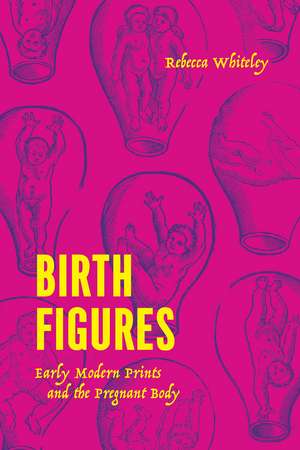Birth Figures – Early Modern Prints and the Pregnant Body
Autor Rebecca Whiteleyen Limba Engleză Hardback – 22 feb 2023
Birth figures are printed images of the pregnant womb, always shown in series, that depict the variety of ways in which a fetus can present for birth. Historian Rebecca Whiteley coined the term and here offers the first systematic analysis of the images’ creation, use, and impact. Whiteley reveals their origins in ancient medicine and explores their inclusion in many medieval gynecological manuscripts, focusing on their explosion in printed midwifery and surgical books in Western Europe from the mid-sixteenth to the mid-eighteenth century. During this period, birth figures formed a key part of the visual culture of medicine and midwifery and were widely produced. They reflected and shaped how the pregnant body was known and treated. And by providing crucial bodily knowledge to midwives and surgeons, birth figures were also deeply entangled with wider cultural preoccupations with generation and creativity, female power and agency, knowledge and its dissemination, and even the condition of the human in the universe.
Birth Figures studies how different kinds of people understood childbirth and engaged with midwifery manuals, from learned physicians to midwives to illiterate listeners. Rich and detailed, this vital history reveals the importance of birth figures in how midwifery was practiced and in how people, both medical professionals and lay readers, envisioned and understood the mysterious state of pregnancy.
Preț: 313.45 lei
Nou
Puncte Express: 470
Preț estimativ în valută:
59.99€ • 62.53$ • 49.94£
59.99€ • 62.53$ • 49.94£
Carte disponibilă
Livrare economică 16-30 decembrie
Livrare express 29 noiembrie-05 decembrie pentru 39.84 lei
Preluare comenzi: 021 569.72.76
Specificații
ISBN-13: 9780226823126
ISBN-10: 0226823121
Pagini: 312
Ilustrații: 6 color plates, 55 halftones
Dimensiuni: 163 x 227 x 26 mm
Greutate: 0.64 kg
Ediția:First Edition
Editura: University of Chicago Press
ISBN-10: 0226823121
Pagini: 312
Ilustrații: 6 color plates, 55 halftones
Dimensiuni: 163 x 227 x 26 mm
Greutate: 0.64 kg
Ediția:First Edition
Editura: University of Chicago Press
Notă biografică
Rebecca Whiteley is a British Academy Postdoctoral Fellow at Birkbeck, University of London.
Cuprins
List of Illustrations
A Note on Terminology
Introduction: Picturing Pregnancy
Part I: Early Printed Birth Figures (1540–1672)
Chapter 1: Using Images in Midwifery Practice
Chapter 2: Pluralistic Images and the Early Modern Body
Part II: Birth Figures as Agents of Change (1672–1751)
Chapter 3: Visual Experiments
Chapter 4: Visualizing Touch and Defining a Professional Persona
Part III: The Birth Figure Persists (1751–1774)
Chapter 5: Challenging the Hunterian Hegemony
Conclusion
Acknowledgments
Notes
Bibliography
Index
A Note on Terminology
Introduction: Picturing Pregnancy
Part I: Early Printed Birth Figures (1540–1672)
Chapter 1: Using Images in Midwifery Practice
Chapter 2: Pluralistic Images and the Early Modern Body
Part II: Birth Figures as Agents of Change (1672–1751)
Chapter 3: Visual Experiments
Chapter 4: Visualizing Touch and Defining a Professional Persona
Part III: The Birth Figure Persists (1751–1774)
Chapter 5: Challenging the Hunterian Hegemony
Conclusion
Acknowledgments
Notes
Bibliography
Index
Recenzii
"In this fascinating porthole into English pregnancy culture in the 16th to 18th centuries, cherubic representations of fetuses in transparent wombs greet bewildered readers . . . . By recasting birth figures as evolving feminist iconography, Whiteley places these artifacts in the context of contemporary debates over reproductive rights."
“During this early-modern period, female midwives delivered most babies. Whiteley convincingly argues that the profusion of midwifery manuals at this time (with drawings mainly by men), ‘triggered a change in how midwives both thought about and treated the laboring body.’ Even though birth figures were sometimes used to exert ‘masculine authority’ over women’s practice, they also helped midwives to ‘envision the body, and particularly the position of the fetus, in a newly concrete way.’ . . . Now as then, the birth figure remains powerful . . . . It empowers, but it can be misused. It is revealing, but also mysterious—a tiny cosmos, in utero.”
“Whiteley’s Birth Figures considers the images of fetal positioning that were included in printed midwifery manuals and helped midwives visualize the presentation of the fetus, whether it was cephalic (ideal) or breech (not good) or impacted (very bad), in order that they might better prepare for a complex birth. These images become an occasion for an intricate meditation: on the nature of the womb, and the unseen; on the representation in static images of dynamic process and bodily transformation; on the contingent and shifting boundary between interior and exterior, nature and history.”
“Provides important insights into early modern body knowledge as well as the relationship between women and men in the field of obstetrics in England.”
“With Birth Figures, Whiteley adds much to our historical understanding of pregnancy and childbirth. Moving beyond old historical narratives of the conflict between male midwives—with their instruments and interventionist approach—and traditional female midwives, who assisted in the natural process of birth, Whiteley presents a more complex and nuanced story of shifting understandings among both men and women and new skill sets required of both male and female birth attendants. The book also adds to the growing literature on the relationship between art and science and the creation of 'visual languages' to convey knowledge of different subjects.”
“The history of midwifery is transformed by this first sustained analysis of printed drawings showing birth presentations in pregnant wombs. Recovering midwives’ pictorial practice while putting anatomy in its place, Whiteley reconstructs how copying drove innovation and viewers made meanings. Her appealing book thus extends reproductive, gender, and visual studies, as well as histories of art, medicine, and the body.”
"Whiteley’s work, at the intersection of medical and art history, beautifully illuminates the multiple meanings of images of unborn children in early modern Europe. She offers fresh, sophisticated, and nuanced interpretations of images that have puzzled me for years!"
